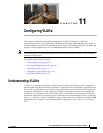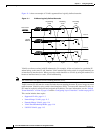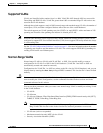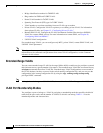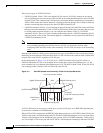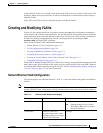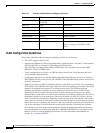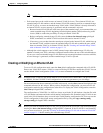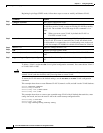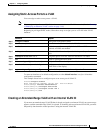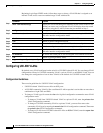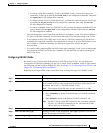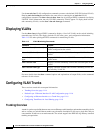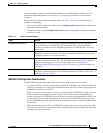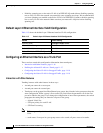
11-9
Cisco ME 3400 Ethernet Access Switch Software Configuration Guide
OL-9639-06
Chapter 11 Configuring VLANs
Creating and Modifying VLANs
Note MSTP is supported only on NNIs on ENIs on which STP has been enabled.
• Each routed port on the switch creates an internal VLAN for its use. These internal VLANs use
extended-range VLAN numbers, and the internal VLAN ID cannot be used for an extended-range
VLAN. If you try to create an extended-range VLAN with a VLAN ID that is already allocated as
an internal VLAN, an error message is generated, and the command is rejected.
–
Because internal VLAN IDs are in the lower part of the extended range, we recommend that you
create extended-range VLANs beginning from the highest number (4094) and moving to the
lowest (1006) to reduce the possibility of using an internal VLAN ID.
–
Before configuring extended-range VLANs, enter the show vlan internal usage privileged
EXEC command to see which VLANs have been allocated as internal VLANs.
–
If necessary, you can shut down the routed port assigned to the internal VLAN, which frees up
the internal VLAN, and then create the extended-range VLAN and re-enable the port, which
then uses another VLAN as its internal VLAN. See the
“Creating an Extended-Range VLAN
with an Internal VLAN ID” section on page 11-11.
• Although the switch supports a total of 1005 (normal-range and extended-range) VLANs, the
number of routed ports, SVIs, and other configured features affects the use of the switch hardware.
If you try to create an extended-range VLAN and there are not enough hardware resources available,
an error message is generated, and the extended-range VLAN is rejected.
Creating or Modifying an Ethernet VLAN
To access VLAN configuration mode, enter the vlan global configuration command with a VLAN ID.
Enter a new VLAN ID to create a VLAN, or enter an existing VLAN ID to modify that VLAN. You can
use the default VLAN configuration (
Table 11-2) or enter commands to configure the VLAN.
Note Extended-range VLANs use the default Ethernet VLAN characteristics and the MTU, the private VLAN,
the RSPAN, and the UNI-ENI VLAN configurations are the only parameters you can change.
For more information about commands available in this mode, see the vlan command description in the
command reference for this release. When you have finished the configuration, you must exit VLAN
configuration mode for the configuration to take effect. To display the VLAN configuration, enter the
show vlan privileged EXEC command.
The configurations of VLAN IDs 1 to 1005 are always saved in the VLAN database (vlan.dat file) with
a VLAN number and name and in the switch running configuration file. Extended-range VLANs are not
saved in the VLAN database; they are saved in the switch running configuration file. You can save the
VLAN configuration in the switch startup configuration file by using the copy running-config
startup-config privileged EXEC command.
Note Before you create an extended-range VLAN, you can verify that the VLAN ID is not used internally by
entering the show vlan internal usage privileged EXEC command. If the VLAN ID is used internally
and you want to release it, go to the
“Creating an Extended-Range VLAN with an Internal VLAN ID”
section on page 11-11 before creating the extended-range VLAN.



